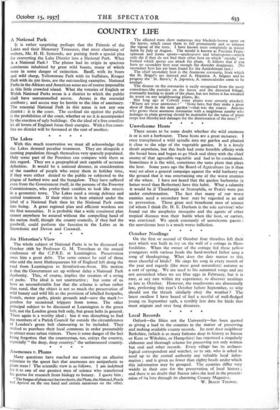Anemones v. Plums
Many questions have reached me concerning an allusive reference to the queer fact that anemones are antipathetic to
plum trees ! The scientific view is as follows. I am indebted for it to one of our greatest men of science who transferred his genius for research from biology to botany. I quote him "The fungus of plum rust has two hosts, the Plum, the Almond, Peach vid Apricot on the one hand and certain anemones on the other.
The affected trees show numerous tiny blackish-brown spots on the leaves, which cause them to fall prematurely and so exhaust the vigour of the trees. I have known trees completely in winter habit by July or August. The mould is known as Puccinia Pruni- spinosae and forms spores—uredospores and telutospores—which only die if they do not find their other host on which oecidia ' are formed which spores can attack the plum. It follows that if you have no secondary host near enough the disorder disappears. (No secondary host has yet been found for the Antirrhinum rust.)
The chief secondary host is the Anemone coronaria' from which the St. Brigid's are derived and A. Hepatica. A. fiilgens and its progeny the 'St. Bavo's,' A. japonica, A. ranunculoides seem to be exempt.
The disease on the coronarias is easily recognised from the nasty comedones-like pustules on the leaves and the distorted foliage, eventually leading to death of the plant, but not before it has wreaked its worst on any neighbouring plums, &c. Not long ago at Colwall some plums were severely attacked. Where are your anemones ? "None here, but they make a great show of them in the next garden '—that was the source. Anyone who grows these anemone coronarias with a neighbour nearby who indulges in plum growing should be mulc-table for the value of plum crops lost thereby and damages for the deterioration of the trees ! "






















































 Previous page
Previous page